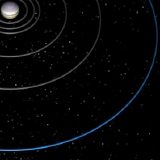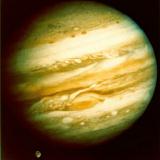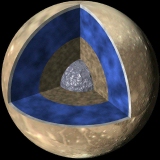 |
||
|
Voyager's
view of Ganymede's complex surface.
|
||
| GANYMEDE - MOON OF JUPITER | ||
| Ganymede, the third Galilean moon of Jupiter, is the largest satellite in the Solar System. If it were in orbit around the Sun it would be regarded a respectable planet. It is much larger than Pluto and slightly bigger than Mercury. Ganymede has ten times the mass of Pluto, but only half the mass of Mercury. | ||
| In Greek mythology, Ganymede was a Trojan boy carried away by Zeus to be a cupbearer to the gods. Zeus is the Greek equivalent of the Roman god Jupiter. Discovered by Galileo Galilei in 1610, Ganymede is bright enough to be seen from Earth using only a pair of binoculars. | ||
 Ganymede's orbit. |
 Voyager 1 image of Ganymede orbiting Jupiter. |
|
| Understanding Ganymede's orbit | ||
| Ganymede orbits Jupiter at an average distance of a million kilometres, completing one revolution in just over seven days. The current orbital eccentricity (0.0015) is too low for Ganymede to be severely disrupted by tidal heating, and yet Ganymede's surface tells a different story. Has Ganymede's orbit been modified in the past, and is this the key to understanding the Ganymede of today? | ||
| Compared to our Moon | ||
| Ganymede has twice the mass of our own Moon, and is over 50% larger. However, the density of Ganymede is less than the Moon's, and hence surface gravity is weaker. Nevertheless, Ganymede is still the most massive of Jupiter's satellites, and is even more massive than the planet Pluto. | ||
 Comparison between our Moon and Ganymede. |
||
| A Layered Structure | ||
| Measurements of Ganymede's gravitational force by the Galileo spacecraft show that Ganymede has a layered structure. The detection of a magnetic field suggests that Ganymede may have a dense metallic core, which in turn implies that Ganymede may once have undergone strong heating. Such heating could start to explain the nature of Ganymede's surface. | ||
 Ganymede's interior. |
||
| More about Ganymede's interior | ||
| Magnetic field | ||
| The Galileo spacecraft has discovered that Ganymede has a weak magnetic field along with a magnetosphere. The magnetic field strength is only about 1% that of Earth's. Magnetospheres surround many of the planets, but Ganymede is the first moon to be found with this planetary attribute. | ||
| Furthermore, as Ganymede itself orbits within Jupiter's magnetosphere, this is the first example of a magnetosphere within a magnetosphere. Ganymede generates its own magnetic field, and this has implications for the interior and structure of the moon. | ||
| Atmosphere | ||
| The Hubble Space Telescope has recently discovered ozone on Ganymede. The origin of the ozone is the rain of charged particles bombarding Ganymede's surface. The charged particles are trapped in Jupiter's strong magnetic field, and are swept through space at Jupiter's rotation rate. As this is faster than Ganymede's orbital speed, the particles overtake Ganymede, shower the surface, and break down Ganymede's water molecules to form ozone. | ||
| The Hubble Space Telescope has also discovered a thin atmosphere of oxygen, similar to the one discovered surrounding Europa. There is also evidence that charged particles impacting on the oxygen are causing polar aurorae. | ||
| More about Ganymede's surface | ||
| The landscape revealed | ||
| The landscape revealed by visiting spacecraft is complex. It has dark cratered regions like Callisto which appear to be old. It has banded terrain like Europa which records more recent tectonic activity. Although inactive now, Ganymede's surface has undergone considerable re-shaping. The origins of many of its features are not fully understood. | ||
 Voyager 2 close-up view of Nipper Sulcus. |
||
| More about Ganymede's surface | ||
| Exploration | ||
| Although Ganymede has been known for over four hundred years, the greatest knowledge of the moon has come from the Voyager and Galileo missions. The wealth of new detail concerning Ganymede will occupy scientists for years to come. | ||
|
|
||